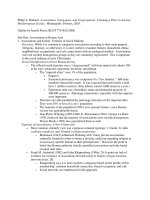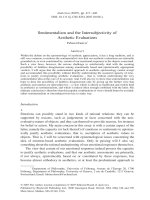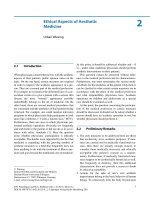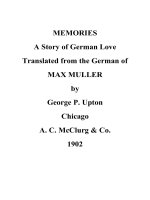Complications of Rhinosinusitis Synopsis of Critical Sequelae ppt
Bạn đang xem bản rút gọn của tài liệu. Xem và tải ngay bản đầy đủ của tài liệu tại đây (3.46 MB, 54 trang )
Complications of
Rhinosinusitis
All images obtained via Google search unless otherwise
specified. All images used without permission.
Viet Pham, M.D.
Patricia Maeso, M.D.
The University of Texas Medical Branch
(utmb Health)
Department of Otolaryngology
Grand Rounds Presentation
April 22, 2010
()
Synopsis of Critical Sequelae
Outline
Standring S, ed. Gray's Anatomy, 40th Ed.
Spain: Churchill Livingstone, 2008.
Anatomy
Rhinosinusitis
Acute
Chronic
Complications
Orbital
Intracranial
Bony
Conclusion
Anatomy
Maxillary Sinus
Largest and first sinus to develop
At 3 months gestation
Volume 6-8cm
3
at birth
Volume 15cm
3
by adulthood
Biphasic periods of rapid growth
First 3 years and between 7-18 years
Coincides with dental development
Natural ostium drains into ethmoidal infundibulum
Accessory ostia in 15-40%
Haller cell can impair drainage
Kennedy DW, Bolger WE, Zinreich SJ, eds.
Diseases of the Sinuses – Diagnosis and
Management. Hamilton: BC Decker, 2001.
Notes: The anterior wall forms the facial surface of the maxilla,
the posterior wall borders the infratemporal fossa, the medial
wall constitutes the lateral wall of the nasal cavity, the floor of
the sinus is the alveolar process, and the superior wall serves
as the orbital floor.
Anatomy
Maxillary Sinus
Bailey, et al. 2006. pp 10.
Innervation via V
2
distribution
Infraorbital nerve
Dehiscent intraorbital canal
in 14%
Vasculature
Maxillary artery and vein
Facial artery
First and second
molar roots dehiscent
in 2%
NOTES: Haller cell is an ethmoidal cell that
pneumatizes between maxillary sinus and
orbital floor.
Anatomy
Ethmoid Sinus
First seen at 5 months gestation
Five ethmoid turbinals
Agger nasi
Uncinate
Ethmoid bulla
Ground/basal lamella
Posterior wall of most posterior ethmoid cell
Between 3-4 cells at birth
Adult size by 12-15 years
Between 10-15 cells
Volume 2-3cm
3
by adulthood
Hansen JT, ed. Netter’s Clinical
Anatomy, 2nd Ed. Philadelphia:
Saunders, 2010.
Kennedy, et al. 2001
Nasolacrimal
Duct
Infundibulum
Uncinate Process
Hiatus Semilunaris
Ethmoid Bulla
Basal Lamella
Retrobulbar Recess
Anatomy
Ethmoid Sinus
Drainage
Anterior cells via ethmoid infundibulum
Posterior cells via sphenoethmoid recess
Innervation via V
1
distribution
Branches from nasociliary nerve
Anterior and posterior ethmoids
Vasculature
Ophthalmic artery
Maxillary and ethmoid veins
Nasociliary Nerve
Anterior Ethmoidal Artery
Posterior Ethmoidal Artery
Ophthalmic
Nerve
Ophthalmic
artery
Posterior cells drain into superior meatus
Ophthalmic artery provides anterior and posterior
ethmoidal arteries
Cavernous sinus gives off maxillary and
ethmoidal veins
Anatomy
Frontal Sinus
Not present at birth
Starts developing at 4 years
Radiographically visualized at 5-6 years
Development not complete until 12-
20 years
Volume 4-7cm
3
by adulthood
No or poor pneumatization in 5-10%
Drainage via frontal recess
Anterior: posterior agger nasi
Lateral: lamina papyracea
Medial: middle turbinate
Tollefson TT, Strong EB. Frontal Sinus Fractures.
eMedicine 13 Jul 2009.
Kennedy, et al. 2001
Frontal Sinus
Frontal
Recess
Basal
Lamella
Infundibulum
Posterior
Ethmoid
Uncinate
Process
NOTES:The anterior table of the frontal sinus is twice as thick
as the posterior table, which separates the sinus from the
anterior cranial fossa. The floor of the sinus also functions as
the supraorbital roof, and the drainage ostium is located in the
posteromedial portion of the sinus floor
A markedly pneumatized agger nasi cell or ethmoidal bulla can
obstruct frontal sinus drainage by narrowing the frontal recess.
Drainage of the frontal sinus also depends on the attachment of
the superior portion of the uncinate process
Anatomy
Frontal Cell Types
Type 1: single cell superior to agger nasi
Type 2: > 2 cells superior to agger nasi
Type 3: single cell from agger nasi into sinus
Type 4: isolated cell within sinus
Type 1
Type 2
Type 3
Type 4
Sold arrow – Frontal cell type
Dashed arrow – Agger nasi cell
DelGaudio JM, et al. Multiplanar computed tomography analysis of
frontal recess cells. Arch Otolaryngol Head Neck Surg 2005; 131:230-5.
NOTES:Type 3 cell
attaches to anterior table.
Anatomy
Frontal Sinus
Vasculature
Supraorbital artery and vein
Supratrochlear artery
Ophthalmic vein
Foramina of Breschet
Innervation via V
1
distribution
Supraorbital
Supratrochlear
Supratrochlear
Nerve
Supraorbital
Nerve
Supratrochlear
Artery
Supraorbital
Artery
NOTES:Foramina of Breschet: small venules that
drain the sinus mucosa into the dural veins
Anatomy
Sphenoid Sinus
Evagination of nasal mucosa into sphenoid bone
First seen at 4 months gestation
Pneumatization begins in middle childhood
Minimal volume at birth
Volume 0.5-8cm
3
by adult
Reaches adult size by 12-18 years
Sellar type (86%)
Presellar (11%)
Conchal (3%)
NOTES: Approximately 25% of bony capsules separating the
internal carotid artery from the sphenoid sinus are partially
dehiscent. An optic nerve prominence is present in 40% of
individuals with dehiscence in 6%.
In most cases, the posteroinferior end of the superior
turbinate was located in the same horizontal plane as the
floor of the sphenoid sinus. The ostium was located medial to
the superior turbinate in 83% of cases and lateral to it in 17%.
Anatomy
Sphenoid Sinus
Innervation via sphenopalatine nerve
V2 distribution
Parasympathetics
Vasculature via maxillary artery and vein
Sphenopalatine artery
Pterygoid plexus
Acute Rhinosinusitis (ARS)
Inflammation of the nasal mucosa and lining of the
paranasal sinuses
Obstruction of sinus ostia
Impaired ciliary transport
Viral etiology in majority of cases
Superimposed bacterial infection in 0.5-2%
Symptoms for at least 7-10 days or worsening
after 5-7 days
Symptoms present for < 4 weeks
“Recurrent ARS” with > 4 episodes, lasting > 7-10
days
NOTES: Most viral upper respiratory tract infections are caused by rhinovirus,
but coronavirus, influenza A and B, parainfluenza, respiratory syncytial virus,
adenovirus, and enterovirus are also causative agents.
Acute Rhinosinusitis (ARS)
Major symptoms
Facial pain/pressure
Facial congestion/fullness
Nasal obstruction
Nasal discharge/purulence
Minor symptoms
Headache
Fever (non-ARS)
Halitosis
Fatigue
Diagnosis with two major or one major and two minor
factors
Hyposmia/anosmia
Purulence on exam
Fever (ARS only)
Dental pain
Cough
Ear pain/pressure/fullness
Acute Rhinosinusitis (ARS)
Microbiology
Children Adults
Streptococcus pneumoniae (30-43%)
Haemophilus influenzae (20-28%)
Moraxella catarrhalis (20-28%)
Other Streptococcus species
Anaerobes
Streptococcus pneumoniae (20-45%)
Haemophilus influenzae (22-35%)
Other Streptococcus species
Anaerobes
Moraxella catarrhalis
Staphylococcus aureus
Chronic Rhinosinusitis (CRS)
Symptoms present for > 12 consecutive weeks
“Subacute” for symptoms between 4-12 weeks
Chronic inflammation
Bacterial, fungal, and viral
Allergic and immunologic
Anatomic
Genetic predisposition
No clear consensus on pathophysiology
NOTES: One of the major problems with identifying the pathogenesis of CRS is that neither symptoms, findings, nor radiographs,
taken independently, are sufficient basis for the diagnosis. One study showed that current symptom-based criteria had only a 47%
correlation with a positive CT scan result.
Stankiewicz JA, Chow JM: A diagnostic dilemma for chronic rhinosinusitis: definition accuracy and validity. Am J Rhinol 2002;
16:199-202.
Chronic Rhinosinusitis (CRS)
Microbiology
Children Adults
Anaerobes
Other Streptococcus species
Staphylococcus aureus
Streptococcus pneumoniae
Haemophilus influenzae
Pseudomonas aeruginosa
Anaerobes
Other Streptococcus species
Haemophilus influenzae
Staphylococcus aureus
Streptococcus pneumoniae
Moraxella catarrhalis
Complications of Sinusitis
Incidence has decreased with antibiotic use
Three main categories
Orbital (60-75%)
Intracranial (15-20%)
Bony (5-10%)
Radiography
Computed tomography (CT) best for orbit
Magnetic resonance imaging (MRI) best for intracranium
Siedek et al, 2010
Complications of Sinusitis
Orbital
Most commonly involved complication site
Proximity to ethmoid sinuses
Periorbita/orbital septum is the only soft-tissue barrier
Valveless superior and inferior ophthalmic veins
Continuum of inflammatory/infectious changes
Direct extension through lamina papyracea
Impaired venous drainage from thrombophlebitis
Progression within 2 days
Children more susceptible
< 7 years – isolated orbital (subperiosteal abscess)
> 7 years – orbital and intracranial complications
NOTES:
close proximity of the orbit to the paranasal sinuses, particularly the ethmoids, make it the most commonly
involved structure in sinusitis complications; rarely from frontal or maxillary sinuses
pediatric population difference likely related to age-related sinus development
* pain and deterioration is not necessarily always present
* increase in WBC only found in 50%
Orbital Complications
Microbiology
Children Adults
Streptococcus species
Staphylococcus aureus
Anaerobes (Bacteroides and
Fusobacterium species)
Gram-negative bacilli
Staphylococcus epidermidis
Streptococcus pneumoniae
Hemophilus influenzae
Moraxella catarrhalis
Staphylococcus aureus
Anaerobes
Orbital Complications
Chandler Criteria
Five classifications
Preseptal cellulitis
Orbital cellulitis
Subperiosteal abscess
Orbital abscess
Cavernous sinus thrombosis
Not exclusive, can occur concurrently
Bailey, et al. 2006.
Orbital Complications
Preseptal Cellulitis
Symptomatology
Eyelid edema and erythema
Extraocular movement intact
Normal vision
May have eyelid abscess
CT reveals diffuse thickening of lid and
conjunctiva
Bailey, et al. 2006.
Orbital Complications
Preseptal Cellulitis
Medical therapy typically sufficient
Intravenous antibiotics
Head of bed elevation
Warm compresses
Facilitate sinus drainage
Nasal decongestants
Mucolytics
Saline irrigations
Ramadan et al, 2009
Orbital Complications
Orbital Cellulitis
Symptomatology
Post-septal infection
Eyelid edema and erythema
Proptosis and chemosis
Limited or no extraocular movement limitation
No visual impairment
No discrete abscess
Low-attenuation adjacent to lamina
papyracea on CT
Bailey, et al. 2006.
Ramadan et al, 2009
NOTES: Patients may complain of pain and
diplopia and a history of recent orbital trauma
or dental surgery.:
Orbital Complications
Orbital Cellulitis
Facilitate sinus drainage
Nasal decongestants
Mucolytics
Saline irrigations
Medical therapy typically sufficient
Intravenous antibiotics
Head of bed elevation
Warm compresses
May need surgical drainage
Visual acuity 20/60 or worse
No improvement or progression
within 48 hours
Harrington JN. Orbital cellulitis.
eMedicine, 25 Oct 2010.
Orbital Complications
Subperiosteal Abscess
Symptomatology
Pus formation between periorbita and lamina papyracea
Displace orbital contents downward and laterally
Proptosis, chemosis, ophthalmoplegia
Risk for residual visual sequelae
May rupture through septum and present in eyelids
Rim-enhancing hypodensity with mass effect
Adjacent to lamina papyracea
Superior location with frontal
sinusitis etiology
Diagnostically accurate 86-
91%
Ramadan et al, 2009
NOTES: Patients will complain of diplopia,
ophthalmoplegia, exophthalmos, or reduced visual
acuity. The patient has limited ocular motility or pain
on globe movement toward the abscess.; may have
normal movement early on. Orbital signs include
proptosis, chemosis, and visual impairment.









